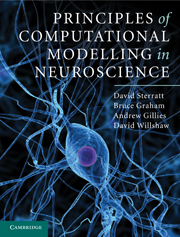Book contents
- Frontmatter
- Contents
- List of abbreviations
- Preface
- Acknowledgements
- Chapter 1 Introduction
- Chapter 2 The basis of electrical activity in the neuron
- Chapter 3 The Hodgkin–Huxley model of the action potential
- Chapter 4 Compartmental models
- Chapter 5 Models of active ion channels
- Chapter 6 Intracellular mechanisms
- Chapter 7 The synapse
- Chapter 8 Simplified models of neurons
- Chapter 9 Networks of neurons
- Chapter 10 The development of the nervous system
- Chapter 11 Farewell
- Appendix A Resources
- Appendix B Mathematical methods
- References
- Index
Appendix B - Mathematical methods
Published online by Cambridge University Press: 05 June 2012
- Frontmatter
- Contents
- List of abbreviations
- Preface
- Acknowledgements
- Chapter 1 Introduction
- Chapter 2 The basis of electrical activity in the neuron
- Chapter 3 The Hodgkin–Huxley model of the action potential
- Chapter 4 Compartmental models
- Chapter 5 Models of active ion channels
- Chapter 6 Intracellular mechanisms
- Chapter 7 The synapse
- Chapter 8 Simplified models of neurons
- Chapter 9 Networks of neurons
- Chapter 10 The development of the nervous system
- Chapter 11 Farewell
- Appendix A Resources
- Appendix B Mathematical methods
- References
- Index
Summary
Numerical integration methods
Most of the mathematical models presented in this book involve differential equations describing the evolution in time and space of quantities such as membrane potential or calcium concentration. The differential equations are usually too complex to allow an analytical solution that would enable the explicit calculation of a value of, say, voltage at any particular time point or spatial position. The alternative is to derive algebraic expressions that approximate the differential equations and allow the calculation of quantities at specific, predefined points in time and space. This is known as numerical integration. Methods for defining temporal and spatial grid points and formulating algebraic expressions involving these grid points from the continuous (in time and space) differential equations are known as finite difference and finite element methods.
It is not our intention here to provide full details of these numerical integration methods. Instead, we will outline some of the simplest methods to illustrate how they work. This includes the Crank–Nicholson method (Crank and Nicholson, 1947), which is widely used as a basis for solving the cable equation. Further details on these methods as applied to neural models can be found in Carnevale and Hines (2006) and Mascagni and Sherman (1998).
- Type
- Chapter
- Information
- Principles of Computational Modelling in Neuroscience , pp. 328 - 350Publisher: Cambridge University PressPrint publication year: 2011



